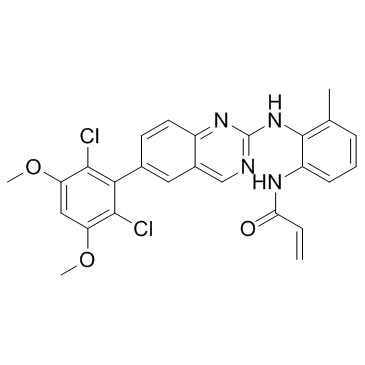1538604-68-0
| Name | N-(2-((6-(2,6-dichloro-3,5-dimethoxyphenyl)quinazolin-2-yl)amino)-3-methylphenyl)acrylamide |
|---|---|
| Synonyms |
blu9931
2-Propenamide, N-[2-[[6-(2,6-dichloro-3,5-dimethoxyphenyl)-2-quinazolinyl]amino]-3-methylphenyl]- N-(2-{[6-(2,6-Dichloro-3,5-dimethoxyphenyl)-2-quinazolinyl]amino}-3-methylphenyl)acrylamide BLU-9931 |
| Description | BLU9931 is a potent, selective, and irreversible FGFR4 inhibitor with an IC50 of 3 nM. |
|---|---|
| Related Catalog | |
| Target |
FGFR1:591 nM (IC50) FGFR2:493 nM (IC50) FGFR3:150 nM (IC50) FGFR4:3 nM (IC50) |
| In Vitro | In MDA-MB-453 cells, BLU9931 potently inhibits phosphorylation of FGFR4 signaling pathway. BLU9931 inhibits proliferation of HCC cell lines that express an intact FGFR4 signaling complex, such as Hep 3B, HUH-7, and JHH-7 cell lines, with EC50 of <1 μM. BLU9931 also inhibits proliferation in PDX-derived cell lines with an intact FGFR4 signaling pathway[1]. BLU9931 induces tumor shrinkage in hepatocellular carcinoma models that express a functioning ligand/receptor complex consisting of FGF19/FGFR4/KLB and adds to a growing list of anti-FGFR4 agents[2]. |
| In Vivo | BLU9931 (300 mg/kg, p.o.) leads to tumor regression and prevents this weight loss in mice bearing the FGF19-amplified Hep 3B liver tumors. In mice bearing the FGF19-overexpressing PDX-derived LIXC012 xenografts, treatment with BLU9931 (300 mg/kg, p.o.) also leads to tumor regression[1]. |
| Kinase Assay | FGFR kinase inhibition assays are performed at KM for ATP. Picomolar to low nanomolar concentrations of FGFR proteins are incubated in 1× Kinase Reaction Buffer (KRB) with 1 μM of CSKtide and 50 to 250 of μM ATP at 25°C for 90 minutes in the presence or absence of a dosed concentration series of inhibitor. All reactions are terminated by the addition of Stop buffer, and plates are read on a Caliper EZReader2. IC50 values are fit with a four-parameter log[Inhibitor] versus response model with floating Hill Slope. |
| Cell Assay | established and PDX-derived HCC cell lines are seeded in 96-well plates in respective growth media, allowed to attach overnight, and treated with a dilution series of test compounds for two cell-doubling times. Cell viability is determined by CellTiter-Glo, and results represented as background-subtracted relative light units normalized to a DMSO-treated control. Relative EC50 values are determined at 50% inhibition between the top and bottom plateau of the dose-response curve. |
| Animal Admin | BLU9931 is formulated in 0.5% carboxymethylcellulose/1% Tween 80 and dosed orally as a suspension twice daily. Sorafenib is dissolved in Cremaphor:EtOH (1:1) and diluted with saline or water to yield the stock solution. Sorafenib is dosed orally once daily. All compound doses are expressed as mg/kg free base. For PK-PD studies, 3 mice are included in each treatment group. Mice receive four doses of compound or vehicle. Blood and tumors are collected 8, 12, 20, and 24 hours following the last dose. The concentration of BLU9931 in plasma is determined by LC/MS-MS. A section of each tumor is immediately frozen in liquid nitrogen and stored at −80°C. |
| References |
| Density | 1.4±0.1 g/cm3 |
|---|---|
| Molecular Formula | C26H22Cl2N4O3 |
| Molecular Weight | 509.384 |
| Exact Mass | 508.106903 |
| PSA | 85.37000 |
| LogP | 5.13 |
| Index of Refraction | 1.677 |
| Storage condition | -20℃ |
